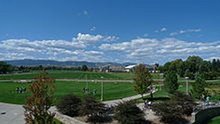Construction has begun on a 12,200-square-foot Equine Reproduction Laboratory (ERL) at Colorado State University less than a year after fire destroyed the original main laboratory building. Construction is expected to be completed by March 2013 in time for the main part of the breeding season.

CSU Campus - Home of Renowned Equine Lab
More than 500 horses are examined annually at Colorado State ERL.
In the meantime, client services, teaching and research activities have continued in other buildings on the grounds. More than 500 client horses are examined annually at the ERL
For 30 years, researchers at the Equine Reproduction Laboratory have developed reproductive techniques benefiting horses and preserving bloodlines. Multiple techniques used today in human and animal reproduction assistance were pioneered at the laboratory, including semen freezing and cooling, embryo transfer and other advanced reproductive procedures.
“Once we recovered from our initial shock because of loss of ERL to fire, we went back to work,” said Dr. Pat McCue, a professor of Clinical Sciences in the College of Veterinary Medicine and Biomedical Sciences and the Iron Rose Ranch Chair in Equine Reproduction.
“The new building is going to be much bigger and serve the next several decades for what we – and our clients – need. Rebuilding the ERL will ensure our mission of being the premier horse reproduction center in the world.”
The ERL has been an active research, education and clinical program within the Animal Reproduction and Biotechnology Laboratory since 1967.
A place for multidisciplinary equine research
Dr. Thomas “Tod” Hansen, professor of Biomedical Sciences, who serves as ERL director, said, “The success of the ERL stems from interdisciplinary research with other ARBL faculty. This interaction results in strong fundamental research that becomes immediately applied to expertise in diagnosis, treatment and management of reproductive problems in mares and stallions.
The new ERL building fosters interactions through nesting mare, stallion and advanced assisted reproductive technology services under one structure. It also houses molecular biology and microbiology laboratories, which will facilitate state-of-the-art diagnostics on site.”
The ERL is home to 11 faculty members from the College of Veterinary Medicine and Biomedical Sciences and the College of Agricultural Sciences, four research associates and numerous postdoctoral students, graduate students and veterinary residents. Courses taught by ERL faculty educate graduate and undergraduate students as well as inform horse owners and veterinarians through continuing education.
“We are grateful to the university and community for their support over the past year and look forward to continuing the long and prestigious research that occurs at the ERL,” said Dr. Colin Clay, chair of the Department of Biomedical Sciences. “We want to reconnect our alumni and friends with the laboratory and share stories of our faculty and students who are improving animal and human lives around the globe.”
Insurance proceeds will cover some construction costs, but fundraising for the project is ongoing.
